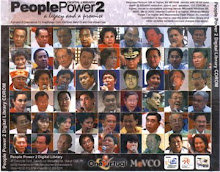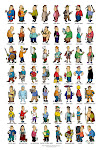The first thing that caught my eye was the word "techdems" in the web site address. I am sure you have your own reasons for using it, but this term is being used also by a volunteer group of technology professionals supporting the Democratic party campaigns in the US, even as early as the 2004 presidential campaign. I Googled the word and I got these two sites, which you may wish to visit: http://www.techdems.org/ and http://www.washblog.com/story
But I fully agree and support your own call for Filipino technology volunteers to share their knowledge, expertise, time and other resources to help improve our people's lives -- to empower them and make them more productive citizens. This is great! Congratulations for initiating something like this. It is an initiative that we need now and which I believe whose time has come. We have so much potential as a country and as a nation, but it seems we have not been able to fully exploit and put to productive use these potentials to effect change -- change (sorry for borrowing this phrase) we can believe in. Knowledge and technology exchange could certainly make a difference. And the greater challenge is how to get these to the right people at the right time. I know there are hundreds, no thousands of Filipinos out there who are just waiting for an opportunity and the right motivation to help in this kind of effort. Remember the word "Bayanihan" which we invented?
Again, congratulations for coming up with something like this (but let's just make sure the blog address is not mistaken as supporting the US Democratic campaign).
Cheers!
Danny F. Pabellon
Assistant Director-General
National Economic and Development Authority
E-Mail: dfpabellon@neda.gov.ph
Gmail address: dannypabellon@gmail.com
Yahoo address: danpabellon@yahoo.com
URL: http://www.neda.gov.ph
Tel. No.: (632) 631-37-29
Fax No.: (632) 635-47-94
Techdems Headline Animator
Friday, May 23, 2008
Time Has Come For Techdems
Sunday, May 18, 2008
The Philippines Needs You
 We would be damned if we can’t do something about the problems our nation faces today. We will grow to a 100 million people in very few years and our problems on food, water, health, education, and other basic needs will be further aggravated by the lack of active and direct citizen participation. We must become part of the solution.
We would be damned if we can’t do something about the problems our nation faces today. We will grow to a 100 million people in very few years and our problems on food, water, health, education, and other basic needs will be further aggravated by the lack of active and direct citizen participation. We must become part of the solution.
UNDP released its data using the latest motion charts, invented by Hans Rosling and acquired by Google. You will see the performance of about 166 countries in the areas of poverty, income, child survival rate, paths to development and other human trends. These motion charts, by the way, are a great source of information that generate various reactions and responses from peoples of different cultures. You will see in these charts that we, peoples of the earth, have the same goals and aspirations in life.
The different paths to development of Egypt and China over 40 years made them achieve similar performance in health and income. Vietnam and China were also compared with the former performing better in health while the latter performed better in wealth. Sweden and Singapore, though far apart and with marked differences in culture, share many common qualities such as technology leadership and vision for the future. They outperformed all other countries in health and income.
The poorest and the richest nations have a hundred-fold difference in income. It is extremely disappointing, if not disgusting, to know that about 30% of children die within the first five years from birth in the poorest country while the richest country enjoys a survival rate of 99.97% percent.
My particular interest is my country, the Philippines. Our GDP per capital in 2003 was $4,080 which was, more or less, our GDP per capita in 1983. We did not move over 20 years. We lost almost a whole generation. This is a complete failure on the part of the Filipinos. And that's just the tip of the iceberg.
The top 20% of the richest Filipinos had a GDP per capita of $10,700 US dollars in 2003; but the poorest 20% had only $1,100 US dollars. Only 1.9 percent of children of the top 20% richest Filipinos died before reaching 5 years old, but a high of 5.2 percent of the poorest Filipino children aged 5 or less did not survive. Do you know exactly how many were these children? Do your math. One thing I'm definitely sure, the rich kids did not die out of poverty. The UNDP study was ending 2003. I am aware of the positive and upward economic performance of our country from 2004 to 2007. We shall incorporate these new figures in the UNDP Google motion charts and update you.
The quality of life that we have today is an effect of our collective decisions and performance in the past. There are peoples in other lands who were more determined in putting their fate and future in their hands. Those who succeeded in the past 25 years were more serious, deeply committed and zealously patriotic than others. But those who lagged behind and failed, like us, need to ask ourselves: what did we do wrong and what do we do now?
Check out this most valuable UNDP report on Human Trends. See how the Philippines performed compared to other 165 countries. You can even download the report and tell us what you think and what we should do to improve our performance. Email us at techdems@mac.com and we'll send you a copy of the UNDP Motion Charts.
Rice Crisis: Solutions within Reach
India, Bolivia, Columbia and some parts of Africa have some valuable experiences that are very helpful to solving our food crises. India implemented a combination of click and mortar solutions with multi-player involvement which helped them achieve rice sufficiency. Click here.
Click here.
Bolivia and Columbia worked on rural communities and studied with enormous depth the social networks and actors that come into play in the supply chain of coffee, peach and chili. Read how Bolivia nurtured their Farmer's capabilities and used Social Networks to solve their Food problems. Download this PDF file. Credit to Louise Clark for her research.
Read how Bolivia nurtured their Farmer's capabilities and used Social Networks to solve their Food problems. Download this PDF file. Credit to Louise Clark for her research.
International Rice Research Institute has a 9 point solution on the rice crisis. Please send an email and we'll send IRRI's studies to you. Lastly, I'm sure you have other solutions in mind, please post them by clicking on "comment" below.
Remember our last People Power 2 Prayer?
I was there with you in 2001 when we as one nation prayed to our Creator to give us strength and wisdom to begin building a new Philippines. We made a pledge to commit ourselves to certain ideals and visions. What did we accomplish? Where did we seem to fail? What can we do now to live up to these ideals and visions?
Friday, February 23, 2001
Supreme Court Chief Justice as CEO
Former Supreme Court Chief Justice Hilarion Davide delivered this speech at the Asian Institute of Management. Let's absorb his ideas and see if our present Supreme Court justices meet the standards of excellence set by their former leader.
Raul Roco's Message to the Filipino Youth
Former Senator Raul Roco gave credit to the Filipino Youth for their role in People Power 2. In this interview I asked him "what's your message to that Filipino kid?" Listen and watch this clip and remember every word he said. What should the Filipino youth do today and how can they participate in the process of development?


